A workshop without a dust collector is a workshop where your lungs are the dust collectors. I have had a dust collector set up inside my shop for several years and I am tired of breathing in the fine dust. Most do let fine particles through into the air so I thought it was time to vent it outside. Before doing this I had plenty of questions, the most important one being, can I vent my dust collector outside? I will show you everything I learned along the way.
A dust collector can be vented outside and is recommended. It is ideal for removing unwanted dust from your shop. Before doing so you must consider your location, neighborhood, and is your shop heated or cooled.
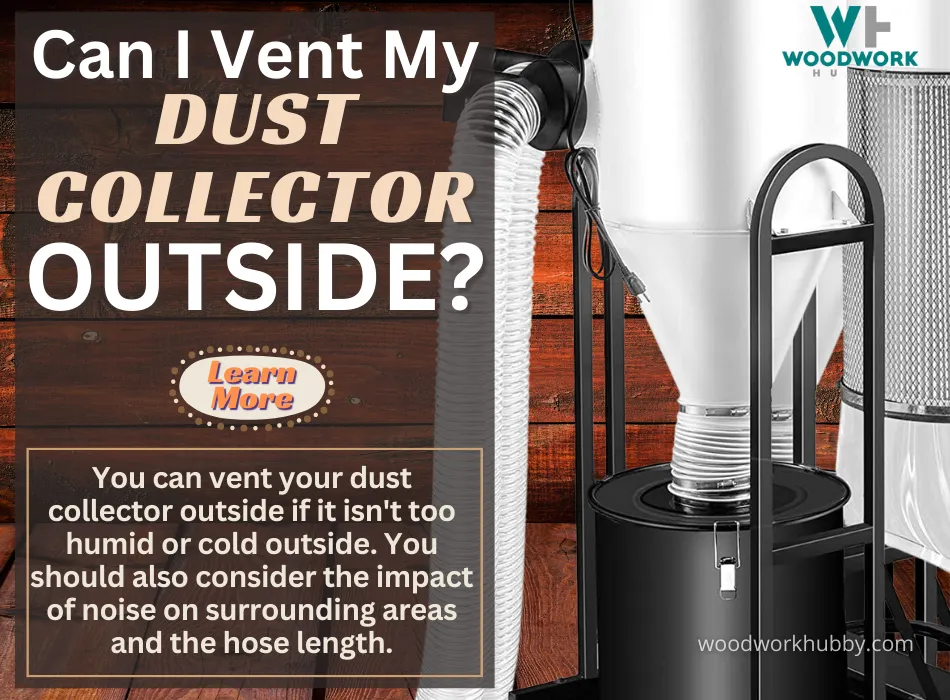
In this article, I will address everything you need to know about placing your dust collector vent outside, including the factors to consider, the things you might need, and the problems you might run into.
I have also included some comments below from a popular Facebook group where members express some important things to keep in mind. Click here to view these.
But first, let’s go over the ideal conditions for placing a dust collector outside.
Be sure to also check out my article where I go over the facts if a dust collector bag can be washed!
Outdoor Placement for Dust Collector: The Idea Circumstances
You already know that your shop needs a dust collector. What you might not know is that outdoor placement is generally better. There is no point in collecting sawdust if it gets back into the workshop air. A good dust collector automatically vents the dust in a way that does not even need to be dealt with. And, of course, this is better done outside than inside.
Video showing how to vent the dust collector externally
Collecting dust inside entails having the dust accumulate in a collection bag inside the workshop. Any dust that escapes is back in the shop atmosphere. Venting outside does the same thing outside the workshop. And the fine dust that escapes doesn’t come back it. Both venting outside and manual collection are viable options. However, you have to consider a few factors to make the right choice.
Factors Affecting Dust Collection Vent Placement
- The dust size – Fine dust that is likely to get airborne again is best not reintroduced to the shop atmosphere. It is the prime candidate for outdoor venting.
- The heat difference – Is your shop warmer or cooler than the outdoors? A dust vent outside will act as a temperature transfer device. Your dust extractor will constantly be drawing your warm or cooled air outside.
- Your Neighborhood – Is your shop close to neighbors’ houses? You should consider noise and any fine dust that may escape outside causing a nuisance for them.
- The shop size – One might assume that a small shop cannot handle collecting dust inside. But most small shops are too small to have any practical need or place for an outdoor dust venting system.
- The humidity level – If the area you live in is very humid, then it is not a good idea to vent your dust collector outside as this can invite moisture into the workshop.
Be very careful with your dust extractor setup. I have heard all the stories about dust explosions so I decided to put this myth to bed when I wrote this article on Do dust collectors need to be grounded?
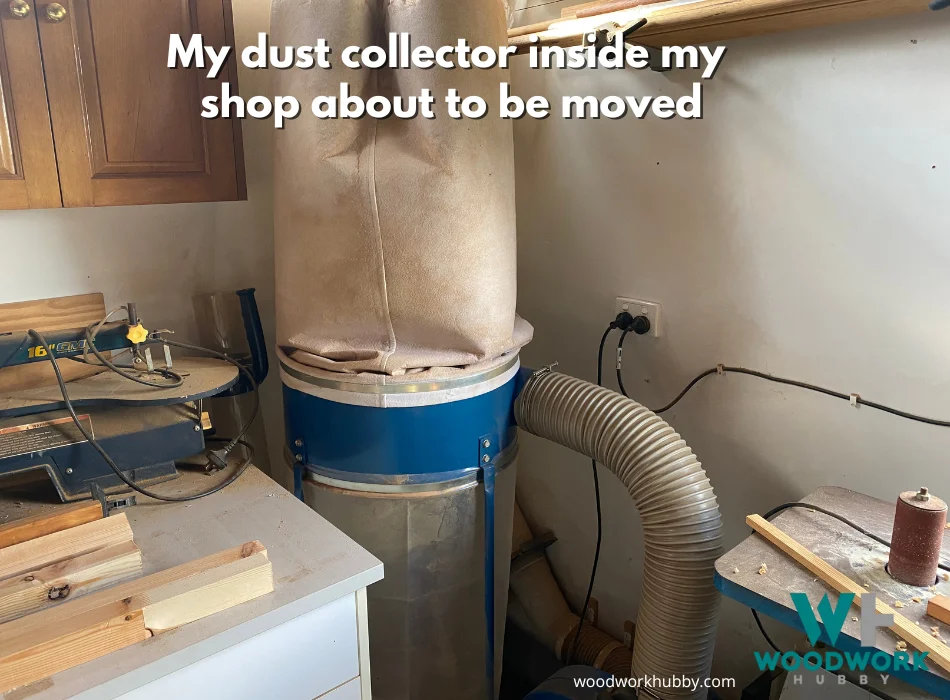
In other words, you can (and probably should) vent your dust collector outside as long as your shop is large enough and it isn’t too cold or humid outside.
From the above, it is clear that venting your dust collector outside is an option in many instances. But what about cases where you cannot vent outside? In those instances, the dust collector has to work as an air filter as well. The dust gets separated in the collection mechanism, and the relatively clean air goes out the vent and back into the shop. It might sound inefficient, but there are reasons why collecting dust indoors can work.
Here is when placing a dust collector inside is fine:
There is also a third option, which is to place the entire collection chamber outside including the suction mechanism.
This is an upgrade from indoor tool-side dust collection and a downgrade from the HEPA air filters often associated with large-scale, secure venting.
- When the dust is not combustible – Often overlooked, the possibility of combustion is one of the key reasons to place the dust collector outside. Given that wood is naturally combustible, it is almost always better to have the dust collected or vented outside.
- When the dust is thick/coarse – If the tools you use or the projects you work on produce flakes of wood or coarse dust, then indoor collection works fine. The air that comes out of the other end is pretty clear of the dust that goes in.
- In contrast, fine dust might not even get caught in the filters and may just get circulated into the air. Another reason thick dust can be collected indoors is that it settles on the ground anyway.
- When the shop is small – As mentioned earlier, shop size makes it more of a logistics issue to install an outdoor vent for their interior dust filter. Therefore most woodworkers working out of small shops have no option but to use standard indoor collectors that blow the “filtered” air back into the workshop.
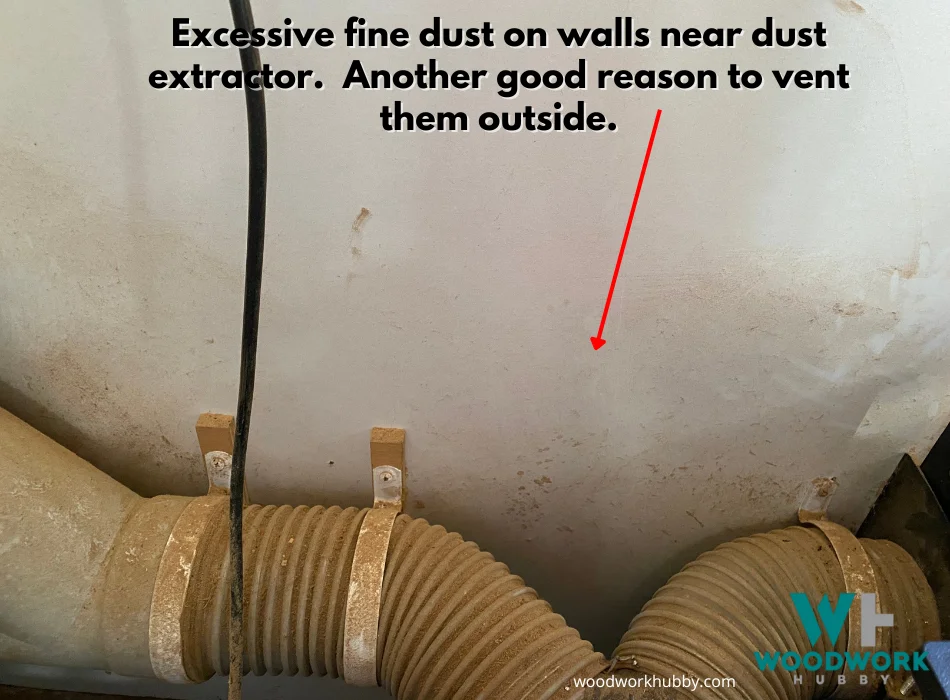
Can You Put a Dust Collector Outside?
You should put the dust collector outside if you can, especially if the dust being collected is combustible. The easier it is for the dust material to catch fire, the more crucial it is to be collected outside.
This is one of three options and it has multiple benefits compared to other ways of setting up your dust collector. Before we get into different pros and cons, let’s look at the three methods:
- Proximity Vacuuming – This entails collecting dust from the proximity of a tool that produces plenty of dust. This mechanism filters the air and releases the remainder inside the workshop.
- Venting Dust Collector Outside – Venting the collector outside requires setting up ducts that can securely take the filtered air outside. This air can contain plenty of fine particles.
- Outdoor Dust Collector Placement – This is the final method of dust collection which we’ll look further into. It requires placing the actual dust bag outside and amping up the suction to work pull air from inside the workshop.
| Pros of placing dust collector outside | Cons of placing dust collector outside |
|---|---|
| It is safer as it reduces the chances of fine dust getting airborne in the workshop. | It requires a long vent hose and higher suction power |
| It reduces the possibility of combustible dust catching fire | It can be expensive and complicated to set up |
| It makes the workshop air breathable for vulnerable individuals like asthmatics and hypochondriacs. | It can be very noisy and is ill-suited for sub-urban environments. |
How To Minimize the Drawbacks of an Outdoor Dust Collector
- Recycle a vent hose – Vent hoses are relatively cheap if you buy preowned ones. If you know what you are doing, you can offset the expensiveness drawback by just being resourceful. A few sources on this are linked later.
- Enclose your dust collector to reduce its noise – While it is true that an outdoor dust collector can be very noisy, it is also true that you can use sound-proofing panels on its right and left sides to minimize its sound. We cover some panels you can use for this later in this post.
- Get a stronger dust collector or change proximity – You can either shorten the length from your worktable to the outdoor collector or amp up the collector’s power. Both of these have the same effect. A stronger dust collector is more expensive while a shorter vent hose can be less practical.
See The Facebook Comments I Got From Users With Some Important Tips
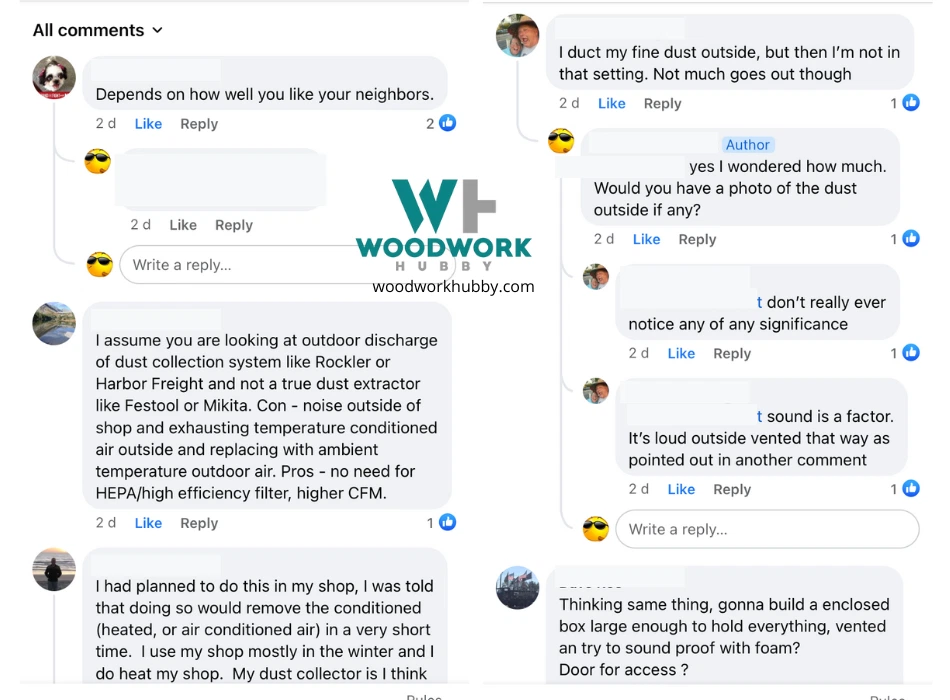

Can You Use a Dryer Vent Hose for Dust Collection?
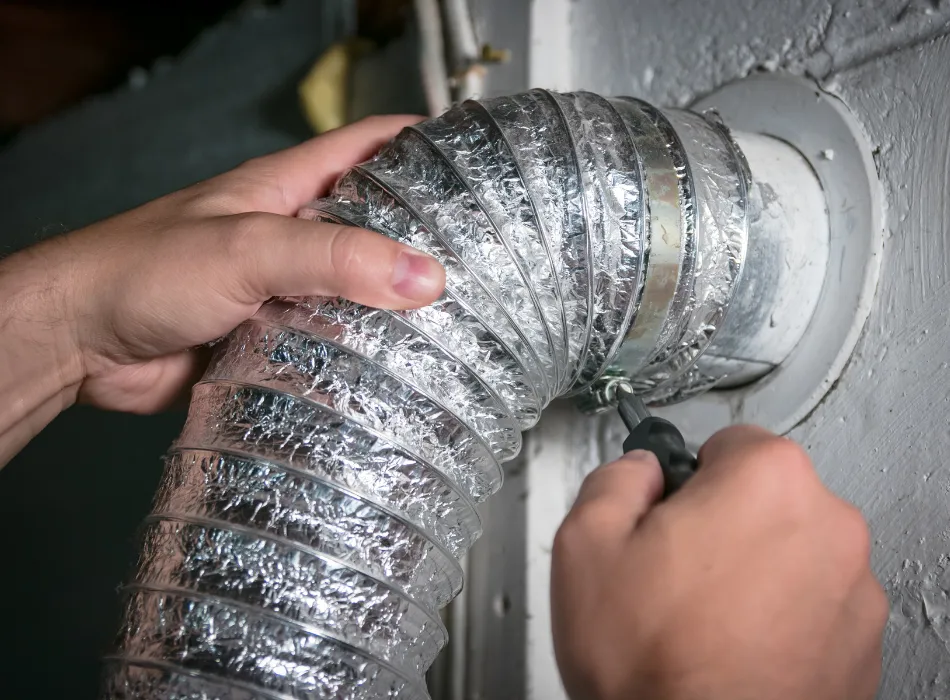
You can use a dryer vent hose for dust collection as long as the dust is fine and the collector piping isn’t getting bumped into. The dryer vent isn’t a suitable long-term solution, though it can work for a few weeks until you can get piping meant for dust collectors.
A Dryer Vent Hose can work for sawdust collection because the dust is too fine to corrode the interior of the hose. When it comes to shavings and coarse wood chips, the vent hose can get damaged. However, even for sawdust collection, the vent can become suboptimal after a while because the hose can come off. The kind of taping/sealing required for a dust collector vent is far tighter than a dryer hose vent.
A dryer hose just funnels out warm air and gaseous output. In contrast, a dust collector specifically collects particles. These can hit the tape and other adhesive mechanisms you use to keep the dryer vent in place. After a while, the tape can come off altogether.
The only advisable use of a dryer vent host for dust collection is for 1 to 2 weeks as a temporary replacement for an actual dust collector vent. And that too when the dust being collected is not coarse or corrosive.
Only two factors aside from filter quality affect the dust collection in your workshop.
- Hose material is one of these factors. The content of dust collection should not be capable of affecting the hose firmness.
- The second factor is suction power. If the air isn’t sucked at a strong enough rate, the dust starts settling instead of going into the dust collector.
How Do You Increase Dust Collector Suction?
The two ways to increase dust collector suction include improving motor power and optimizing the suction mechanism. Both of these can be broken down into actionable steps, like cleaning the filter and making the venting hose shorter.
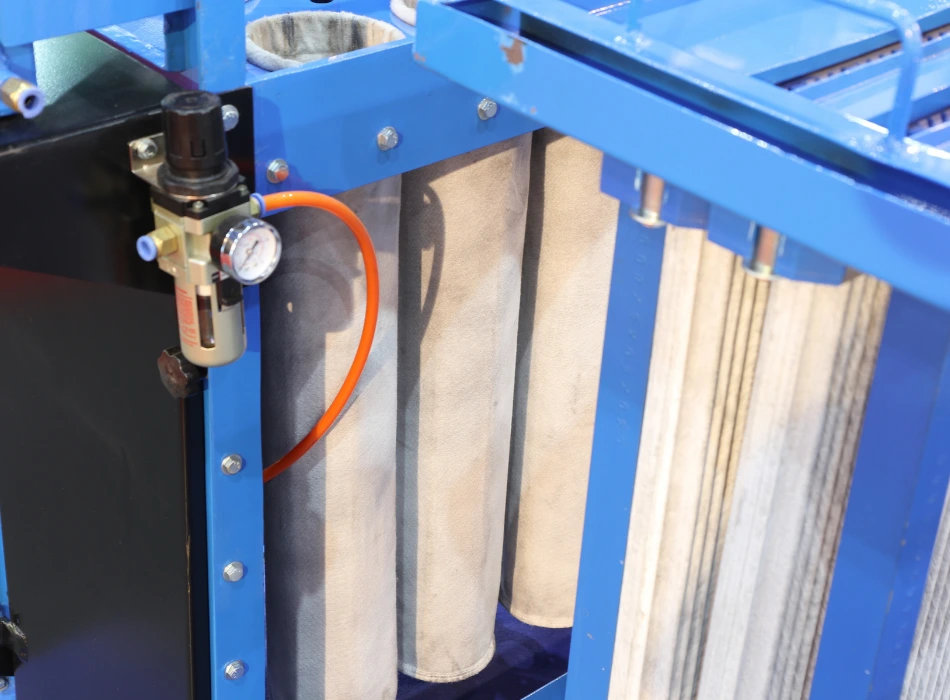
A higher-power motor is the most effective way of improving suction because air suction is primarily powered by a motor. And the more powerful the motor, the better suction the dust collector mechanism has. This method has its disadvantages as well.
Both the drawbacks of stepping up the motor power have to do with cost. Buying a more powerful suction motor costs more money. And running it also increases the cost of electricity.
The second method of improving suction is to cut the hose shorter. This can be done by moving your workbench closer to the wall and also by having the dust collector placed inside. One of the greatest perks of placing your dust collector indoors is that it is very power-efficient.
But this also pollutes the shop air if the sawdust is extra fine. In my experience, at least 5% of the sawdust escapes most filters. Even filters that claim to be 99% efficient are practically 90% effective.
The third way to make your shop’s dust collection more effective is to check for leaks in the venting hose. A minor breach in the vent hose connection can result in a significant loss of efficiency. Anything from how the venting hose is connected to the collector to the angle of the hose can be the culprit. So examine the venting hose with an open mind and a working dust collector.
One way to sniff out the air leaks is to cover the hose in soap lather. Any air passage from a hole will cause bubbles in the area with the breach. Covering this can improve your dust collector’s suction power. Since leaks aren’t supposed to exist, fixing them is non-negotiable. There are no disadvantages to this step.
Similarly, another step worth taking is cleaning the filter. It is a non-negotiable action item with no downsides. It also affects the airflow regardless of whether it is or is not the primary culprit.
Other Articles On Dust Collectors I Have Written Which May Help You.
Best dust collector for drum sanders and why
Can you wash out dust collector bags?
Best dust collector for Saw Stop
Final Thoughts – Can I Vent My Dust Collector Outside?
You can vent your dust collector outside and probably should unless elongating the dust collection system compromises the suction power. For the most part, though, venting your dust collector inside isn’t a good idea, and you’re better off investing in a higher-power motor so you can afford outdoor venting.



